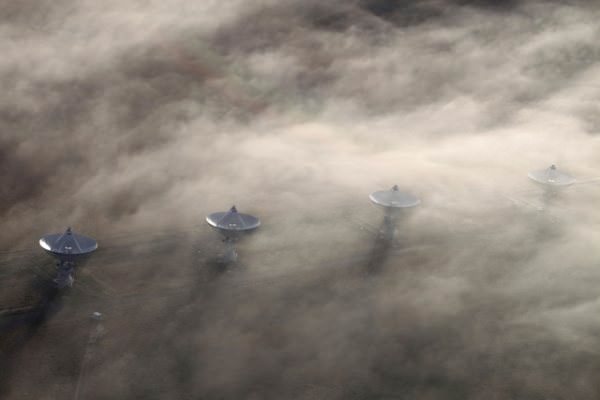It’s time once again for another Where In The Universe Challenge. This image was sent in by UT reader Brian Hinson. Name where in the Universe this image was taken and give yourself extra points if you can name exactly what it is. Post your guesses in the comments section, and check back on later at this same post to find the answer. To make this challenge fun for everyone, please don’t include links or extensive explanations with your answer. Good luck!
UPDATE: The answer has now been posted below!
This very otherworldly-looking image was — as many of you guessed — taken on Earth (although I liked the Besspin and Venus references!) Brian Hinson VLA submitted a few images he took while out for a plane ride. “I took a friend flying over the VLA here in New Mexico and took some other-worldly shots of the
antennas with some ground fog,” he wrote. “I thought perhaps you could do a WITU….The VLA has done so much historic radio astronomy work over the decades that they need a nod, methinks.”
So here’s the nod: Check out the VLA website (where you can see images of the antennas without the fog!)
Also, Brian has a Flickr page where you can see a few more of his VLA images, and more.
Thanks Brian, for sending in your unique image. If anyone else has images or suggestions for a future WITU, let Nancy know.


I’m pretty familiar with the National Radio Astronomy Observatory here in West Virginia, and I’m pretty sure that’s not it … although the lovely clouds would be typical for a foggy morning here. I’m thinking it’s probably the Very Large Array in New Mexico.
The VLA or Magdelena Ridge Observatory near Socorro New Mexico.
LC
LOL. This is such a challenge. I’m gonna say Venus. There be clouds, eh? 😀
No, really… a linear set of radar dishes in the desert, what could it be? I’ll be damned if it ain’t the VLA. Cool clouds, though.
The “Australia Telescope” or “Australia Telecope Compact Array” near Narrabri in north-western zNew South Wales!
The tracks and dish shape do seem to point to the now (almost) Expanded Very Large Array telescope on the Plains of San Agustin some fifty miles west of Socorro, New Mexico.
Looks to me like Cloud City, you know, Lando Calrissian’s Tibana gas mines. The planet is thus Bespin. That’s my guess.
The alien base on Venus. Just look at all those clouds.
I checked images of the Wallops VA and Gilmore Creek AK NOAA CDA facilities, but they don’t have four of those evenly spaced, absolutely identical dishes. So I’m going to have to go along with the conventional wisdom here and say it’s the VLA at Soccoro NM.
I’m with those who say the VAL outside Socorro, NM. My husband has been there, and this looks like an aerial version of the pics he’s taken: instruments even spaced, on what look like railroad tracks, etc.
That would the the VLA, not the VAL.
Earth!!! The Very Large Array in New Mexico!!! Awesome shot!
Must be VLA, but will it be so cloudy in New Mexico?
I was going to say the Australia Telescope Compact Array near Narrabri New South Wales, but the antennae on the dishes doesn’t look quite right. So I guess its the Very Large Array in New Mexico. (I’ll be very embarrassed if it is the ATCA!)
That is the Apple testing facility in Cupertino.
Those are the new iPhone 4.1 with the new antenna to fix the reception problems.
the word is that the solution was subbed out to Microsoft….
Gotta be part of a radio astronomy array. Donno which or where.
Martian Defence Forces, Camp J’onzz, Valles Marineris, while several camouflaging dust-storm generators had broken down. (What, you thought all those dust devils are natural?) Source unknown: it was published through WikiLeaks. Camp J’onzz shot down more Earth probes than any other MDF base.
Since so many have already mentioned the VLA, I’ll be different (and probably wrong) and say the Allen Array near Hat Creek in upstate California. If nothing else, the fog is more consistent with that location than with central New Mexico.
Damn. Too many folks already with my idea of Venus. I expand it by saying that these were former umbrellas used by Venusians during sever “rain” showers. They are not used anymore. They were shot with the ESA’s orbiter Venus Express. Normally they are hidden beneath the very thick clouds, but once in a while a severe storm pushes the clouds away, so you can spot them for a very brief moment. It was just plain luck to capture that image, which was released prematurely by Dimitar Sasselov. It should have been covered another 6 month for scientists to get their data and hide the dishes.
Bespin, however, is also possible!
😉
Having flown over the VLA in small planes and visited it a few times, i would be very suprised to find out that is anywhere else. It is a fun place to tour. I have never seen it that cloudy, but they make the place look exceptional. Great shot. Wish i could send a few of my shots. Great place to take a group of highly intelligent and motivated teenagers. Thank you, Brian
bcj cap saf